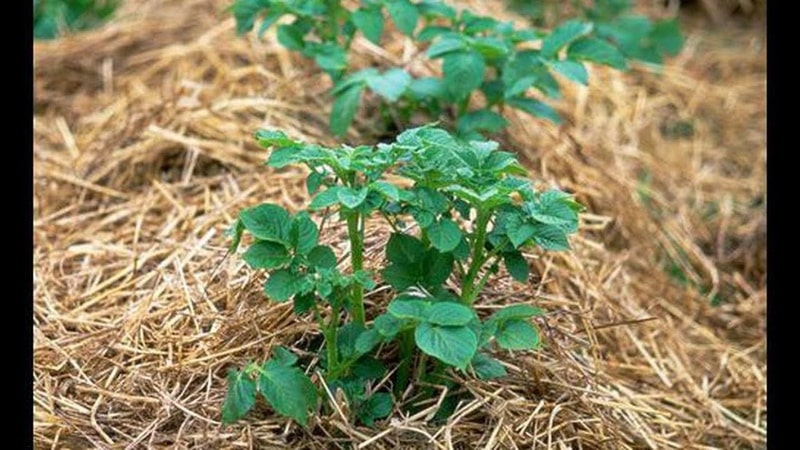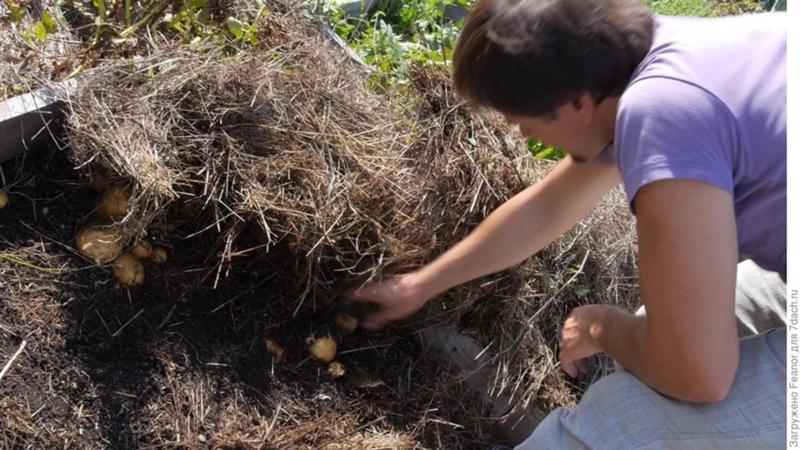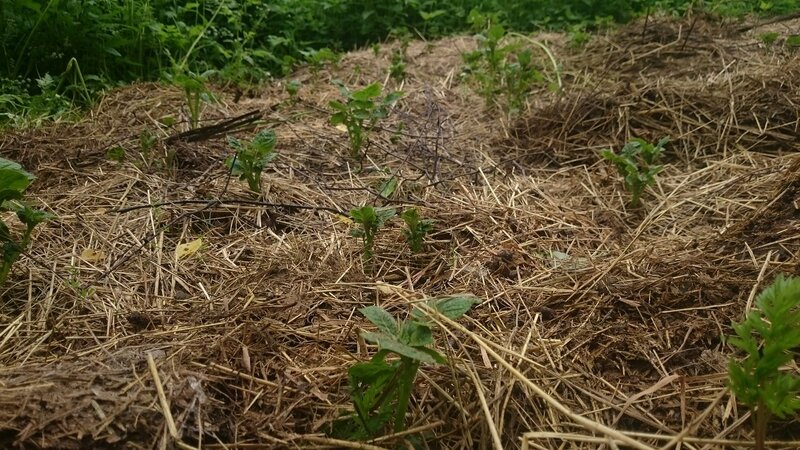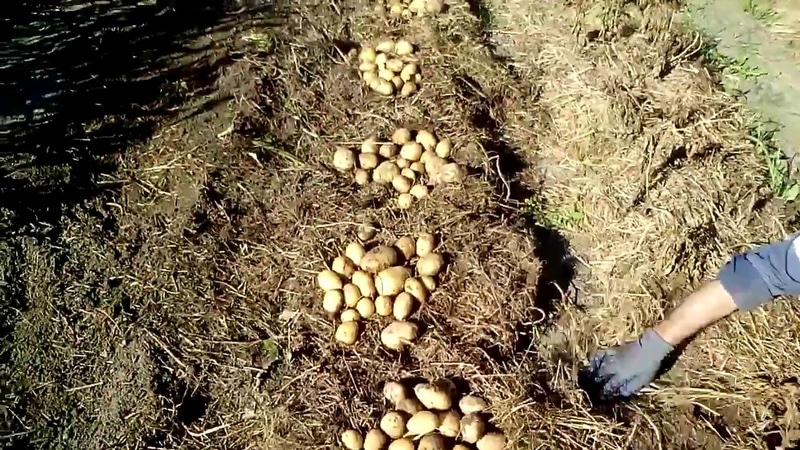How to plant potatoes under straw in the garden
There are many options for planting potatoes that take less time and effort than the traditional method and still produce a rich harvest without the use of chemicals. One of them is growing potatoes under straw. The material nourishes plants, protects from adverse weather conditions, and retains moisture.
Growing potatoes under straw
Such vegetables grow not in the ground, but on it. Nutrition and protection are provided by a thick layer of straw covering the tubers and moist soil. Planting and care are simpler: no digging of soil, weeding, or hilling of bushes is required. From one bucket of planting material you can get up to 10–12 buckets of potatoes.

Features of the method
Dried stems of cereals and legumes are well suited for this method: when they rot, they fertilize the soil. If there is not enough straw, use hay, combined with cardboard.
Reference! The same straw is used for several years in a row. After harvesting, it is dried and save until next season.
Planting potatoes under straw in the garden is hassle-free: digging, weeding, fertilizing, and watering are eliminated or reduced. When harvesting, it is enough to lift a layer of straw and collect clean tubers.
Advantages and disadvantages
The main advantages of growing potatoes under hay:
- saving effort and time on site preparation and maintenance;
- protection from temperature changes, frost, hail, moisture retention in hot weather;
- reducing the number of pests, especially Colorado potato beetles;
- biological fertilizing (worms grow in the lower layer, which create nutritious humus).
Main disadvantages:
- rodents live in straw;
- raw material is favorable for the reproduction of slugs;
- costs for covering material: the initial coating, as it settles, decreases by 50% and requires replenishment during the summer;
- greening of tubers from exposure to sunlight with an insufficient layer of straw.
Planting options

There are 2 main ways of planting potatoes under straw: classic and alternative.
Classical
Sequence of work:
- The selected area is slightly loosened with a hand cultivator or a flat cutter, parallel grooves are made 5–8 cm deep, with a distance of 60–70 cm between them. In another option, the tubers are laid directly on a grass bed.
- Sprouted potatoes are placed in the grooves in increments of 30–40 cm.
- Cover the vegetables with a layer of hay or straw 20–25 cm thick.
- After the first shoots appear, the plants are hilled up, straw is added between them (a layer up to 20 cm in height).
It is important to avoid getting the covering material on the sprouts so as not to damage them.
Alternative
In this method, potato seeds are placed in small holes, sprinkled with earth on top, and only then the entire area is covered with a 20–25 cm layer of straw.
Important! For arid climates, soil mixed with sand and clay, this is a more reliable option.
Everything else is done as in the classic method: rows with holes - every 30–40 cm, the distance between rows is 60–70 cm.
Minimum straw
Since it takes a lot of straw to cover potatoes, some gardeners mix it with household cardboard. Household appliance boxes are suitable for this.
The material is laid out on the ground, cross-shaped cuts are made at the planting sites and holes are formed for the tubers at a distance of 30 cm from each other. Keep 60 cm between the rows. The entire bed is covered with the prepared cloth. Vegetables are planted in prepared holes, and the entire structure is covered with straw 10–15 cm high.

Landing rules
The basis for a rich harvest is laid in advance: in the fall, the area is prepared for planting, and the seeds are germinated in early spring.
Preparing the bed
To improve the composition of the soil, add:
- compost or humus, preferably 2-3 years old;
- dry ground citrus peel: its smell repels rodents;
- finely ground egg shells: disinfects the soil;
- ash: effective against wireworms.
Fertilizers are scattered on the ground and lightly loosened with a rake.
Green manure plants are planted in future potato beds: alfalfa, rye, oats, phacelia, mustard. As a result, in the spring you get soil saturated with useful substances, without weed.
Tuber preparation
Seeds prepared in March. The tubers are sorted out and damaged and infected specimens are removed. Small potatoes the size of a chicken egg are suitable for planting. They are dipped in a weak solution of potassium permanganate for 10 minutes, dried and placed in boxes.
Containers with planting material are left for 3 weeks in a cool, dry place (at +5...+15°C). This time is enough for sprouts to appear.
Features of care and cultivation
When growing potatoes under straw or hay, follow some rules:
- Plant the crop in heated (at least +10°C) soil. Otherwise, seedlings will not appear for a long time.
- Do not place the plot in a shady part of the garden.
- The soil must be kept moist at all times.
- To prevent potatoes from turning green, they are buried 5–7 cm into the soil.
- The layer of straw is formed quite high: 20–25 cm. It is lightly compacted or a little earth is poured on top so that the wind does not carry the material around the garden.
- If the summer is dry, the potatoes are watered periodically.
When the tops dry, they begin harvesting. To do this, lift the mulch layer and move it to the side. If desired, potatoes can also be harvested during the summer when they are young. They move the dry grass apart carefully, without damaging the bushes, so that they continue to grow under their cover.
Tips and tricks

For the first time, potatoes are planted under straw in a small area. The results are compared with those obtained after traditional cultivation.
Healthy! Potatoes for planting next year are selected during the harvest this year.
Ultrasonic rodent repellers are installed in the garden. To combat slugs, plants that pests cannot tolerate are scattered around the garden bed: garlic, horseradish, wormwood, nettle, mint, tansy, parsley, lemon balm. If this is not enough, special drugs are used: “Slug Eater”, “Thunderstorm”.
Reviews from gardeners
Opinions about the method vary. Experienced gardeners get a good harvest. Those who experimented for the first time had more modest results.
Valentina, Odintsovo: “Last year I conducted an experiment. It was a pity to throw away the remains of the sprouted potatoes. She laid it out between the rows on the mown grass. I covered it with straw, then added freshly cut lawn grass. But I made the rows too close - it was inconvenient to add mulch. I liked this semi-lazy method, and I’m continuing the experiment this season. It’s convenient to harvest: lift the hay, take out what you like, close it, and let it grow further.At the end, I moved the entire straw blanket and collected clean tubers.”
Sergey, Izhevsk: “I’ll share my experience of how I grew potatoes under hay: I planted 7 varieties 5–10 tubers each. I didn’t spend a lot of time on this: I laid out the tubers on the ground and covered them with dry grass. Of course, it's easier than digging with a shovel. As the potatoes grew, I forgot to add material. I think that’s why I got a lot of green tubers when harvesting. There were mice - I brought 2 cats, but after a few days the mice disappeared. I left 1 cat in the house. Because of the hay, the tops came out later than usual. There were few beetles, but there were still some. Different varieties produced different yields. I concluded that for this method it is better to select tubers. It wouldn’t hurt to cover the area with something opaque, at least in the first half of growth.”
Alexander, Krasnodar: “When people ask me how I planted potatoes and got so much harvest, I answer: “Under straw.” It preserves ideal microflora in the beds. The tubers under it are warm and humid, they turn out tasty and large. I plant no more than 2 buckets, and collect no less than 12.”
Conclusion
Growing potatoes under straw is attractive due to the simplicity and biological purity of the resulting crop. The classic method is used or combined with alternative ones. It is important not to forget the general rules of agriculture: the correct choice of planting material, care for soil fertility, and crop rotation.